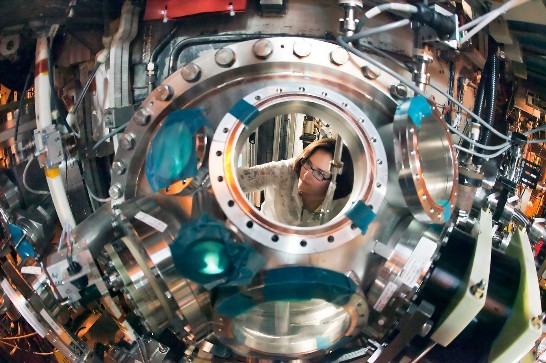
DOE Makes Plans for U.S. Fusion Energy
The Department of Energy (DOE), Office of Science, is processing the Fiscal Year (FY) 2014 Omnibus Appropriations Act request from for strategic United States (U.S.) involvement in advancing fusion energy. The Act requires the Fusion Energy Sciences (FES) Advisory Committee (FESAC) to submit a plan for fusion energy research based on four possible scenarios. The first three scenarios assume a baseline appropriation of $305 million. The first entails a growth rate of 2% based on the Office of Management and Budget’s (OMB) inflators for FY 2015 – FY 2024. The second scenario is also based on OMB’s inflators plus a cost-of living-adjustment (COLA). The third scenario is flat funding. The fourth scenario is based on the President’s $266 million request, in addition to COLA and OMB inflators.
The 10-year plan, to be submitted by January 2015, assumes U.S. participation in the International Thermonuclear Experimental Reactor (ITER). ITER is an international nuclear fusion research and engineering project with seven members including the European Union (EU), U.S., China, Russia, Japan, India and Korea.
FES provides advice on complex scientific and technology issues to the Director of the Office of Science. FESAC has been advised to use the January 2013 Nuclear Science Advisory Committee’s report on nuclear physics priorities and programs as a model.
FESAC has been asked to create a plan that will ensure long-term U.S. leadership in fusion energy, particularly in plasma science, remaining within their appropriations from Congress and based on the four scenarios listed above. This includes prioritizing facility creations or closures, research initiatives, partnerships with federal and international universities and organizations, and student engagement.
It is important that FES retain their competitive edge within the DOE Office of Science to ensure the growth of fusion energy; it will be essential that the U.S. uses international resources, such as ITER, in this effort. Fusion energy is an advancing energy field which international competitors are hoping to create and commercialize; the U.S. should not be left behind in this venture.
Fusion energy, which uses fuel extracted from seawater and lithium, combines small atoms together in order to release helium gas. Unlike fission energy there is no chain reaction and therefore no possibility of a meltdown. Fusion essentially mimics the process of stars in a self-sustaining reaction that has posed challenges for scientists around the world. The current roadblock to successfully generating energy from fusion is that it still takes more energy to begin the reaction than it produces.
ASP is in support of an aggressive fusion development program. We suggest a Congressional authorization of $30 billion over the next ten years in order to ensure that our domestic and international fusion energy development programs continue. Fusion research has a large showing across the U.S. We believe that the federal government should challenge American engineers and scientists to build a domestic fusion facility within the next decade.
Multiple nuclear programs currently exist within the DOE Office of Science including DIII -D, C-Mod, and National Spherical Torus Experiment (NSTX) research and operations; Small Business Technology Transfer (SRRT/SBIR); international research; education and outreach; design studies; materials research; plasma science research and a fusion simulation program.
The DOE Office of Science has outlined general guidelines for U.S. nuclear fusion research falling into four broad categories: Burning Plasma Science for Foundations, Long Pulse, and High Power; and Discovery Plasma Science. Foundations goals include furthering the basic understanding of plasma science prediction and control, particularly through partnerships with universities and student engagement. Growth for the program proposes advanced and spherical Tokamak theory and simulation. Tokamaks use magnetic fields to confine plasma and create equilibrium.
Long pulse goals are to go beyond national and university partnerships and to conduct research on indefinitely maintaining a burning plasma state. This is expected to require further U.S. involvement and investment in ITER, continuing Tokamak research and development, and Stellarator involvement. Stellarators, like Tokamaks, are a fusion device that is used to confine hot plasma within magnetic fields. High power goals primarily include greater U.S. involvement in ITER.
Discovery fusion science goals already include research on high-energy density experiments and plasma control; it is proposed that research on these should continue to grow. Also proposed is further development for SBIR/STTR.
ASP is in support of the development measures proposed by the DOE Office of Science as they hope to advance fusion energy goals; we also believe that the President should appoint a Fusion Power Commissioner to streamline the research, development and commercialization of fusion energy.
Dr. Mark Koepke has been pegged to chair the FESAC subpanel. He is a professor of Physics at West Virginia University in the Department of Physics and Astronomy. He has a particular focus on Plasma Physics.






[…] DOE Makes Plans for U.S. Fusion Energy […]
[…] While most of the questioning surrounded the problems of ITER and the international fusion program, Representatives Veasey (D-TX) and Clark (D-MA) asked about the domestic research program. Dr. Sauthoff said that greater funding for fusion research could allow more runtime and operations on America’s “world class facilities.” Dr. Dehmer said that the current process that the fusion community is undergoing to provide a strategic plan for fusion research will be important in determining what can be done with future funding levels. For more on this process, see ASP’s post “DOE Makes Plans for U.S. Fusion Energy.” […]